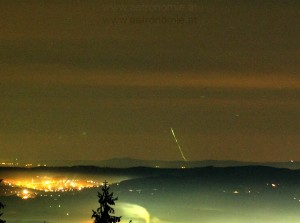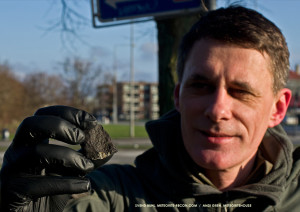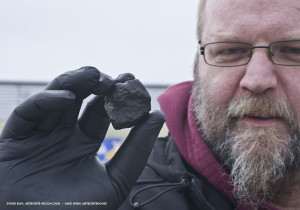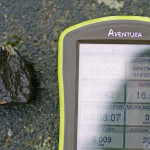EJBY
Eleven recovered meteorites (H5/6, S2, 8982.4 g)
of the fall in Glostrup near Copenhagen
(Hovedstaden, Denmark) on 6 February 2016 at 21:07:18-23 UTC
LAST UPDATE: 2 February, 2021
The exhibitionAccording to a press release of the Statens Naturhistoriske Museum published on 10 February 2017 the 15 finders of Ejby meteorites are going to be paid 2 million dansk kroner (286,000 dollars) as financial compensation for the 8982.4 grams of meteorites handed over to the authorities according to the danekræ * law. For the first time all the Ejby meteorites handed in were on display together at the Geologisk Museum during the winter holidays in February 2017 (7th-8th calender week). Detailed information (finder, size, weight, find location etc.) about the exhibited Ejby specimens were apparently not given. This made it difficult to identify the individual specimens in the exhibition.

Ejby meteorite exhibition at the Geologisk Museum in February 2017. The small specimen on the right of the background row in the glass cabinet on the right seems to be the first Ejby specimen (58.8 g) which was found. The top shelf in the glass cabinet on the left seems to contain larger fragments of the Herlev mass and possibly Ole Henningsen’s 510.4-g-specimen. The middle shelf of the left cabinet contains some intact specimens. Photo: Anders Peter Schultz, Statens Naturhistoriske Museum

The two fragments of the broken specimen in the front seem to be the first Ejby specimen (56 g) which was found. Image: TV2 Lorry, 10 February 2017

Ejby meteorite exhibition in February 2017 – Middle shelf – Front row (left to right): Two large and some small fragments (maybe of the Herlev mass) – Martin Dyrbye’s Vanløse find (18.1 g) – Melina’s meteorite (64.6 g) – Beautiful large intact individual (maybe Ejby 2 or Ejby 9)
Background row (left to right): Broken fragments – Broken fragments – Ejby-5 (58.5 g) Buhl/Gren – unknown intact specimen / Image: dr.dk, 10 February 2017

Ejby meteorite exhibition in February 2017 – Beautiful large intact individual / Image: dr.dk, 10 February 2017

Ejby meteorite exhibition in February 2017 – Melina’s meteorite (64.6 g) showing her crayon markings. / Image: dr.dk, 10 February 2017

Ejby meteorite exhibition in February 2017 – Bottom shelf – Selection of broken fragments / Image: dr.dk, 10 February 2017
Video: TV2 Lorry, Nyhedsudsendelse (7.30 p.m. 10 February 2017) 00.37-01:23 min.
Video: DR Nyheder (10 February 2017)
On August 27, 2016 EJBY (H5/6, S2, W0) was officially registered in the Meteoritical Bulletin Database. Eleven meteorites with a total mass of 8982.4 g have officially been registered.
On March 4, 2016 the Natural History Museum announced * that by this day nine meteorites with a total weight of about 10 kg had been found. During the week before March 4, 2016 four meteorites had been handed over to the museum.
As initially inofficially reported by Lars Malmgren on March 5, 2016 * the finder of the 510.4 gram specimen has found another specimen of 350 g , thus possibly Ejby 9. Additionally, the finder’s father-in-law is reported to have found a meteorite of 431 grams, thus possibly Ejby 8.
The Ejby meteorites
The first Ejby meteorite (Ejby 1, 58.8 g)
An elderly woman from Ejby (Glostrup) who had gone out to smoke a cigarette found a fragment of a ‘strange looking stone’ two meters from the front door on the grey paved path in front of her one-story house in Bjergbakkevej 222 in Ejby, Glostrup (55°42.02’N, 12°24.33’E). She presented it to her son and daughter-in-law who decided to send a photo of the specimen to Dr Henning Haack from the Statens Naturhistoriske Museum in Copenhagen. On visual inspection Haack confirmed that it was in fact a fresh meteorite, an ordinary chondrite.
When visiting the finder in the evening of February 7 Dr Haack and his son found the two smaller fragments of the meteorite which had been fragmented on impact. The meteorite has been sent to Italy for analysis to have confirmation that the presented meteorite is in fact a freshly fallen meteorite of the bolide on February 6, 2016. The terrestrial age will probably be determined by analysing short-lived cosmogenic radioisotopes
(e.g. 46Sc, 57Co, and 54Mn). The analysis will probably be done by Dr Matthias Laubenstein at the Laboratori Nazionali del Gran Sasso (LNGS) at the Istituto Nazionale di Fisica Nucleare. These measurements are usually essential to have found meteorites confirmed as fresh falls. Furthermore the measurements of other cosmogenic radioisotopes will enable the determination of the cosmic ray exposure age as well as the preatmospheric size of the meteoroid. The three fragments of the Ejby meteorite were on public display during an exceptional open hour for two hours (16:00-18:00 CET) at the Geologisk Museum in Copenhagen on February 8, 2016.

Dr Henning Haack presenting the fragments of the Ejby meteorite to the media on 7 February 2016 (image: dr.dk)
Radio report with interview (from 1:32 min.) with Dr H. Haack (Nyheder, Radio24syv, 8 pm , 7 Feb. 2016)
The Herlev main mass (Ejby 3 , 6695.8 grams)
On February 8 Dr Daniel Wielandt from the Geological Museum reported that additional fragments of a second meteorite, which had hit a pavement with a velocity of more than 300 km/h and shattered on impact, had been found by 47-year-old master bricklayer René Rasmussen at this location (55°43’03.2″N 12°26’49.0″E) in 41-year-old Eva Diemar’s backyard in Herlev on Monday morning (Feb. 8, 2016). After the collection of the meteorite fragments by Dr Daniel Wielandt Eva Diemar herself spent up to five hours looking for additional meteorite fragments. She is reported to have found between 659 and 681 grams of fragments * * up to ~ 16 meters away from the impact pit. With the fragments she found on February 9 she is reported to have found about 730 grams in total, which have been handed over to the Geological Museum. Apparently employees of the Geological Museum returned to the impact site in order to collect more fragments which had been overlooked during their first visit. All found fragments included a total mass of 6695.8 grams has been published for the Herlev mass.
René Rasmussen had first assumed the discovered rock fragments were ordinary pieces of concrete * but then saw the fusion crust on them and remembered what he had seen about the Ejby meteorite on TV Sunday evening. The meteorite fragments (1 2 3) he found have been dried and are curated at the Geological Museum in Copenhagen. One of the largest fragments * of the Herlev mass with a weight of 635 grams could be seen at the Geological Museum in Copenhagen * between February 15 and 28, 2016 (see video below).

A partly crusted 635 gram fragment in situ. It’s one of the largest, if not the largest fragment of the second meteorite found at a private parking area in Herlev on Feb. 8 / Photo: TV2

Melina’s meteorite (64.6 g) / The brick red zone which can be seen on the left side of the meteorite in the photo above reveals Melina’s beautiful attempt to make the black rock more attractive by coloring it with one of her red crayons. Hopefully Melina’s crayon markings will never be removed from this specimen. / Photo: glostrupskole.dk
The 6-year-old school girl Melina Hybel Jensen found another 64.4 g specimen in the grass in front of her primary school (Skovvangsskolen *) in Glostrup while being on her way home from school Monday afternoon (Feb. 8). Having talked within the family about how it would be to find a meteorite on Sunday evening, her father Thomas and her mother Marie Louise told her to watch out for curious looking stones. The next day Melina found the meteorite next to her brother’s classroom. Because of its unusual black colour she showed it to her friends and later to her family which contacted Henning Haack and sent a photo. The meteorite was inspected by Haack at the Jensen’s home in the evening of February 9 and subsequently taken to the Statens Naturhistoriske Museum. The information about the find was first published on the school’s website * on February 9.
[wc_row][wc_column size=”one-third” position=”first”]
The video on the right shows Henning Haack visiting Melina at home to confirm the authenticity of her meteorite (Danmarks Radio, Feb. 9, 2016, 22:04 CET)
[/wc_column][wc_column size=”two-third” position=”last”][/wc_column][/wc_row]
The Vanløse meteorite (Ejby 11, 18.1 g)
[wc_row][wc_column size=”one-third” position=”first”] [/wc_column][wc_column size=”two-third” position=”last”]On February 8 * and February 16 it was reported * that another meteorite with a weight of 18.1 grams was found by Martin Dyrbye * in his garden at location 55°41’44.1″N 12°28’40.2″E * in Egholmvej 53 in Vanløse on February 8. The meteorite has been handed over to the Geological Museum and will be on display.
[/wc_column][/wc_row]
Martin Dyrbye’s meteorite (18.1 g) found in Egholmvej 53 in Vanløse/ Photo: Martin Sørensen / Vanløse Bladet

Martin Dyrbye’s meteorite (18.1 g) found in Egholmvej in Vanløse/ Photo: Martin Sørensen / Vanløse Bladet
Ejby 5 (58.5 g)
Another complete meteorite specimen with a weight of 58.5 grams was found at location 55°41’34.5”N, 12°25’59.3”E * in Ejby (Glostrup) on February 13 at 10.45 a.m. CET by renowned German amateur meteorite enthusiasts Dr. Svend Buhl (Meteorite Recon) and Andreas Gren (Meteoritehouse) after a short but systematic search in the projected strewn field based on the bolide’s luminous and dark flight trajectory which had been meticulously calculated by Dr. Karl Wimmer based on publicly available data. Svend Buhl has documented the story of their recovery expedition on his website.
Respecting Danish law the meteorite was handed over to Daniel Wielandt of the Geological Museum on February 14. The Folkebladet published an article by Jesper Ernst Henriksen about the find in its February 17 print edition. Unfortunately the original article does not mention that the recovery of the meteorite was a collaborative effort of S. Buhl and A. Gren. The credit for this find must be equally attributed to A. Gren and S. Buhl. This oversight has partly been corrected in the online version * of the article.
In general it must be said that given the efforts invested in finding these freshly fallen meteorites it is decisive for the speedy recovery of any future meteorite fall in Denmark that the finders of meteorites of this fall who have willingly handed over their hard-earned finds to the authorities are compensated adequately. Meteorite recovery has always been most efficient when it was understood and undertaken as a collaborative project of ambitious amateurs and professional researchers and institutions. Only this cooperation guarantees the manpower, time and determination needed to recover a maximum amount of the scientifically important unweathered specimens of any future meteorite fall. It remains to be seen if in this particular case with its multiple meteorite finds, which make this fall a precedent in Denmark, the application of the current Danekrae law has been flexible, transparent and foresighted enough to meet the unique requirements which an event like a meteorite fall demands and which are beneficial to the advancement of meteoritics in general. UPDATE (10 Feb 2017): Unfortunately the compensation, though financially adequate, has been merely ‘financial’ and thus might not meet every finder’s expectations.
Ejby 6 (510.4 g)
On February 25 at about 1:45 p.m. a meteorite fragment weighing 510.4 grams, which is said to have been found in a small crater in a lawn next to a paved path in Ejby while walking a dog on February 9, was presented by the middle-aged finder at the Geological Museum. The meteorite is said to have been embeded in the ground with its top side being about 5 cm below the ground level. It’s possible that missing fragments of the mass were remaining in the ground when the large fragment was removed. Ole Henningsen went to the museum on February 25 and took these two photos of the meteorite.
The second photo of the 510.4 gram Ejby mass can be seen here (photo: Ole Henningsen).
Danekræ
Because of the Danekræ law, introduced in 1989, the anonymous woman, René Rasmussen, E. Diemar, M. Jensen, M. Dyrbye, S. Buhl, A. Gren and all the other finders of meteorites will receive an adequate finder’s fee from the Natural History Museum for providing the meteorites to the Danish state. It remains to be seen if for this specific meteorite fall a way of compensation has been found, i.e. one which measures up to the different expectations of everybody involved in the recovery of meteorites and at the same time guarantees a successful cooperation for any future meteorite fall in Denmark.
Unconfirmed meteorite finds
It’s likely that other meteorite specimens or fragments have been found by other known or unknown meteorite hunters which have not officially been reported to the Naturhistoriske Museum.
The KPL sound recordings
Kristian Pontoppidan Larsen * claims to have recorded the detonation boom of the bolide in this audio recording MP3 recorded at about 21:08:23 UTC (8:23 running time) at a distance of about 15 km from Ejby and Herlev. The recorded sounds could be caused by the traffic on the road’s surface.
Frank W. Rasmussen though has recently analysed Larsen’s claim and comes to the conclusion that the noticeable sounds in the KPL recording could actually be the sonic booms of the different Ejby meteoroid’s fragmentation events. Find Rasmussen’s full report here. Feel free to send your comments on his report to continue scientific discourse on this potentially relevant and still rather unexplored aspect of the Ejby meteorite fall. Relevant comments will be published below Rasmussen’s report.
The bolide
On 9 June 2016 Pavel Spurný presented the following poster about the bolide (EN060216) at the Meteoroids conference at the European Space Research and Technology Centre (ESTEC) in Noordwijk, the Netherlands. The poster contains the results of the analysis of some available instrumental records, both photographic images (Kühlungsborn, Bad Doberan) and radiometric light curve data (radiometer of the Czech Růžová station). The authors provide basic parameters describing the meteoroid’s atmospheric trajectory and heliocentric orbital data (with an aphelion in the outer part of the asteroid main belt).
P. Spurný, J. Borovička, G. Baumgarten and D. Heinlein (Meteoroids Conference 2016, 9 June 2016: Poster session 4, 09:00 – 9:30).
The luminous trajectory of the rather fragile 50-cm meteoroid weighing about 250 ± 100 kg began at an altitude of about 85.53 ± 0.02 km above location 55°26’57.1″N, 11°54’41.8″E, about 7.55 km east of Ringsted, and a most probable velocity of 14.52 ± 0.10 km/s and terminated at a height of 18.28 ± 0.05 km above location 55°40’36.1″N, 12°18’10.1″E, about 18 km west of the Copenhagen. The luminous trajectory had an average slope of 62.07 degrees to the horizontal and a length of about 76.12 km (35.29 km on the ground). The first fragmentation occurred at an altitude of about 53 km. Several distinct fragmentations and flares could be detected. The brightest of these with an absolute magnitude of -14.0 ± 0.7 happened at an altitude of 26 km above location 55°38’49.2″N, 12°15’21.6″E. The fragmented Herlev mass was found 10.23 km (6.36 mil) from the calculated end (distance on the ground) of the luminous trajectory. On 1 December 2016 the study Atmospheric trajectory and heliocentric orbit of the Ejby meteorite fall in Denmark on February 6, 2016 by P. Spurný, J. Borovička, G. Baumgarten, H. Haack, D. Heinlein, and A.N. Sørensen was published as ‘accepted manuscript’ in Planetary and Space Science. The data in the tables below are the ones given in the Planetary and Space Science manuscript.
Orbital Data (J2000.0)
| a (AU) | 2.81 ± 0.09 | ω (°) | 197.75 ± 0.10 |
| e | 0.655 ± 0.011 | Ω (°) | 317.211 |
| q (AU) | 0.9677 ± 0.0004 | i (°) | 0.96 ± 0.10 |
| Q (AU) | 4.64 ± 0.18 | Period Y | 4.70 ± 0.23 |
Radiant Data (J2000.0)
| Observed | Geocentric | Heliocentric | |
| Right ascension (°) | 82.28 ± 0.05 | 77.78 ± 0.09 | — |
| Declination (°) | 32.60 ± 0.30 | 26.87 ± 0.38 | — |
| Ecliptical longitude (°) | — | — | 54.18 ± 0.20 |
| Ecliptical latitude (°) | — | — | 0.95 ± 0.10 |
| Initial velocity (km/s) | 14.52 ± 0.10 | 9.44 ± 0.16 | 38.51 ± 0.13 |
Q = Aphelion, q = Perihelion, a = Semi-major axis, e = Eccentricity, i = Inclination, Ω = Ascending node longitude, ω = Argument of perihelion

Ejby luminous trajectory (according to P. Spurný, J. Borovička et al.) and meteorite fall locations.

Bolide captured by the Kühlungsborn camera (54°07’00.6″N 11°46’19.2″E / 91m a.s.l.) of the Leibniz-Institute of Atmospheric Physics e.V. (IAP). The Kühlungsborn photo (exposure time 10s) was taken 183.1 km (113.8 miles) from the fall location of the large mass in Herlev and about 148.42-176.74 km (distance on the ground) from the bolide. The photo captures the bolide’s luminous trajectory from its height of 73.2 to 18.3 km altitude and a length of 62.1 km. / Photo: Dr. Gerd Baumgarten

The bolide has been captured in this photo by Erwin Filimon taken at the observatory Gahberg (47°54’48″N, 13°36’33″E/ 860m a.s.l.) in Austria, i.e. about 871.5 km from the impact location of the Herlev mass and about 846.09-867.94 km (distance on the ground) from the bolide. / Photo: Erwin Filimon

Bolide captured (excerpt) by Dr. Baumgarten’s Allsky camera in Bad Doberan (54°05’47.1″N, 11°55’19.1″E). The photo (exposure time 30s) was taken 183.36 km (113.93 miles) from the fall location of the large mass in Herlev and about 150.42-177.40 km from the bolide (distance on the ground). The photo captures the bolide’s luminous trajectory from its height of 85.5 to 18.4 km altitude and a length of 76 km. / Photo: Dr. Gerd Baumgarten

Close-up of the photo on the left by Erwin Filimon at the observatory Gahberg (47°54’48″N, 13°36’33″E/ 860m a.s.l.) in Austria, i.e 871.5 km (541.5 miles) from the impact location of the Herlev mass and about 846.09-867.94 km from the bolide (distance on the ground). / Photo: Erwin Filimon
Kim Østergaard’s surveillance camera in Ho in Vestjylland captured a part of the bolide’s luminous trajectory. The camera is stationed at this location 55°32’58.6″N, 8°13’53.4″E i.e. about 265.21 km (164.79 miles) from the impact location of the Herlev mass. The video captures the bolide’s luminous trajectory from its height of 51.9 to 36.4 km altitude and a length of 17.5 km.
(Video: Kim Østergaard)
EJBY (Meteoritical Bulletin Database):
“Ejby 55°42.02’N, 12°24.33’E
Hovedstaden, Denmark
Confirmed fall: 2016 Feb 6
Classification: Ordinary chondrite (H5/6)
History: (H. Haack, NHMD): A bright fireball was observed over eastern Denmark Feb. 6, 2016, 22:07:19 (UTC+1). It was overcast in the area below the fireball, but many people reported having seen a very bright light. Pictures of the fireball were taken from three locations in Germany and one in Austria (at a distance of 890 km) by automatic cameras designed to take pictures of noctilucent clouds. A surveillance camera on the Danish west coast also recorded a video of the fireball. None of the cameras in the Danish fireball network had clear skies during the event. 279 reports with observations of the fireball and/or sound phenomena were received by the Danish fireball network. Loud sonic booms were heard by many people up to 30 km from the place where the meteorites were found. The day after the fireball was observed the first meteorite (60 g fragment) was found on the tiles in front of the main door of a private house in Ejby, which is a suburb in the western part of Copenhagen. The owner of the house had not seen the rock before. Later that day 6.5 kg of shattered fragments were found on the tiled courtyard of a business property. These fragments had not been there when the business closed on Friday – the day before the fall. During the following 19 days a total of 11 individual meteorites were found in an area measuring 5 × 5 km. The biggest piece weighed 6.5 kg. It hit a tiled area and shattered into hundreds of fragments.
Physical characteristics: 11 meteorites have been recovered, with a total mass of 8938 g. Some of the fragments were recovered wet and the weights are therefore decreasing as the samples dry out.
Petrography: (M. Patzek and A. Bischoff, IfP). Based on the study of the thin sections, Ejby is unbrecciated. Highly recrystallized areas with large plagioclase grains were observed, and areas with abundant relict chondrules also exist. Thus, the rock is transitional between type 5 and 6. In places, high metal and sulfide abundances were found. Olivine shows undulatory extinction indicating that the rock is very weakly shocked (S2). As opaque phases metals (kamacite, taenite), troilite, and chromite were observed. Other accessory phases include Cl-apatite and merrillite.
Geochemistry: (M. Patzek and A. Bischoff, IfP). The mean composition of olivine is Fa19.3±0.1 with a compositional range of Fa18.8-19.5 (n=19). The low-Ca pyroxenes have a mean composition of Fs16.9±0.2 (n= 21), range Fs16.4-17.2. Mean plagioclase is An11.5±0.9Or6.0±1.6 (n= 10; range An9.0-12.8). Kamacite has mean Ni- and Co-concentrations of 6.3 and 0.45 wt%, respectively (n=8). The taenite composition has 48.7±2.8 wt% Ni (mean Co: ~0.05 wt%; n=10).
Specimens: Except for a few small fragments of the 6.5 kg main mass, all recovered fragments are at NHMD.“
Publications:
Ejby — A new H5/6 ordinary chondrite fall in Copenhagen, Denmark
PDF (OPEN ACCESS)
Meteoritics & Planetary Science 54, no. 8 (2019): 1853-1869
H. Haack, A. N. Sørensen, A. Bischoff, M. Patzek, J.‐A. Barrat, S. Midtskogen, E. Stempels, M. Laubenstein, R. Greenwood, P. Schmitt‐Kopplin, H. Busemann, C. Maden, K. Bauer, P. Morino, M. Schönbächler, P. Voss, T. Dahl‐Jensen
Meteoritics & Planetary Science. First Published: 30 June 2019
E.Filimon: “Meteoritenfall über Kopenhagen von der Sternwarte Gahberg aus fotografiert”, VdS-Journal für Astronomie 58, 2016, p. 135
S.Binnewies: “Der Bolide am 6. Februar 2016”, VdS-Journal für Astronomie 58, 2016, p. 136
WEB LINKS
VIDEO LINK (TV2 / 7 Feb.)
VIDEO LINK (elektrabladet / 7 Feb.)
LINK (dr.dk / 7 Feb.)
LINK (dr.dk / 7 Feb.)
LINK (tv2 / 8 Feb.)
LINK (Statens Naturhistoriske Museum, Feb.8)
LINK (extrabladet, Feb.8)
LINK (tv2 / 8 Feb.)
LINK (tv2lorry / 8 Feb. 2016)
LINK (tv2 / 8 Feb.)
Ostsee-Zeitung (Feb. 8)
ekstrabladet (9 Feb.)
Glostrup Skole, Feb. 9
TV2 (Feb.9)
dr.dk (Feb. 9)
dr.dk (Feb. 9)
Vanløse Bladet (Feb. 16)
rnn.dk (Feb. 16)
Folkebladet (Feb. 17)
meteorite-recon
EJBY in the Meteoritical Bulletin Database (August 27, 2016)
Atmospheric trajectory and heliocentric orbit of the Ejby meteorite fall in Denmark on February 6, 2016 (December 1, 2016)
Statens Naturhistoriske Museum press release (10 February 2017)
TV2 Lorry (10 February 2017)
dr.dk (10 February 2017)


























































